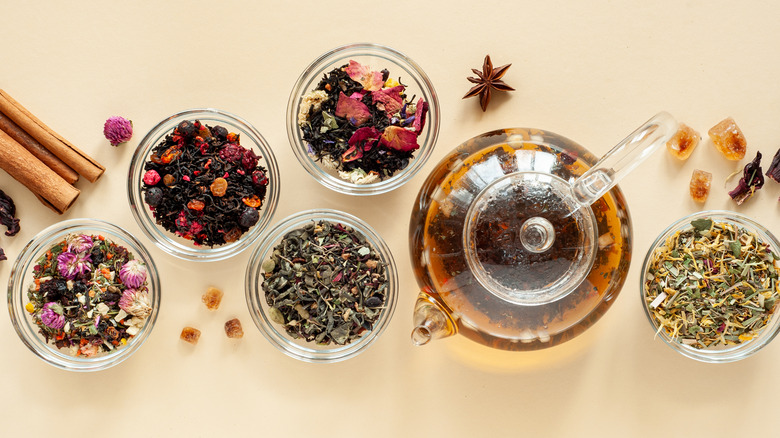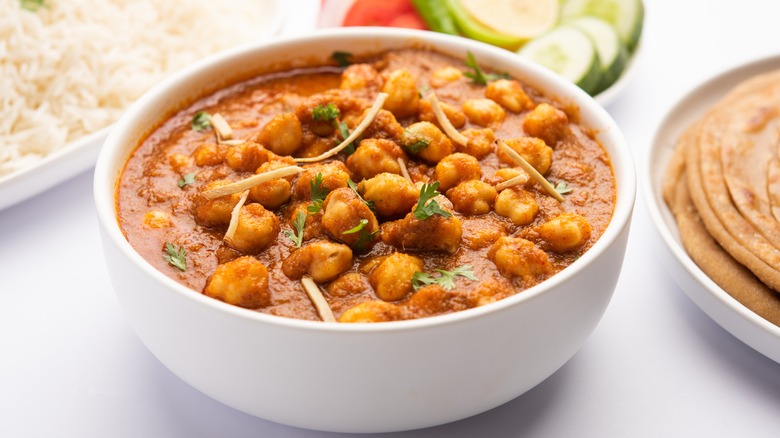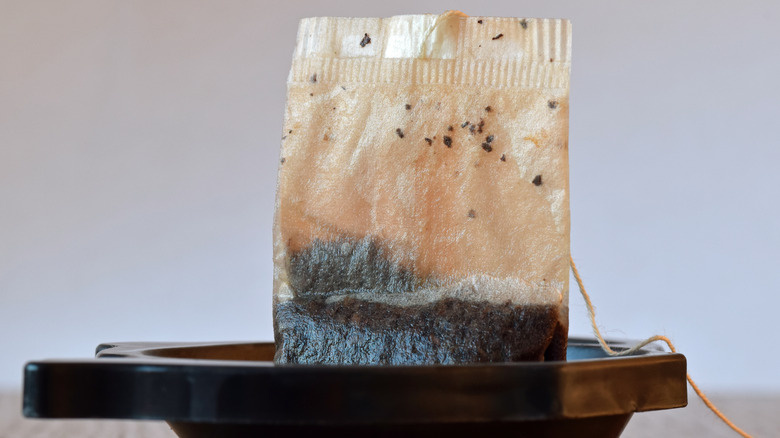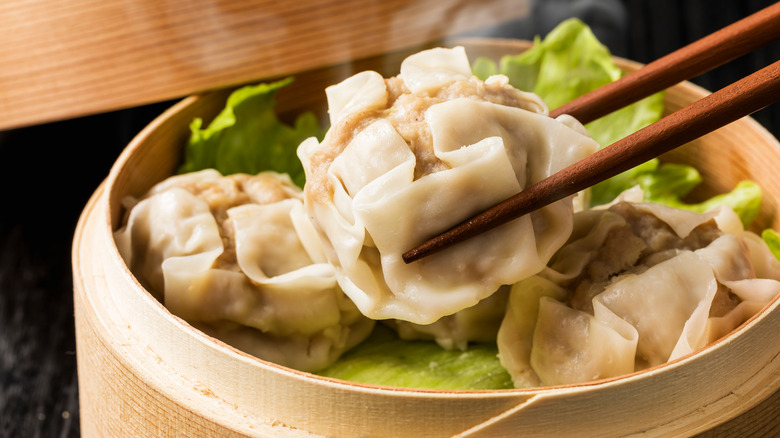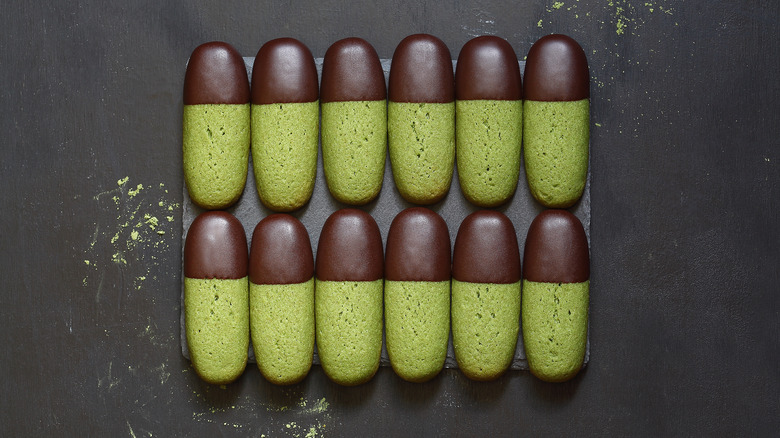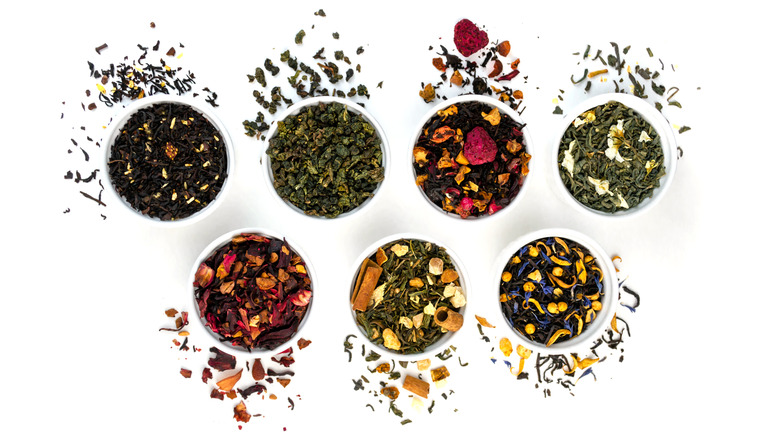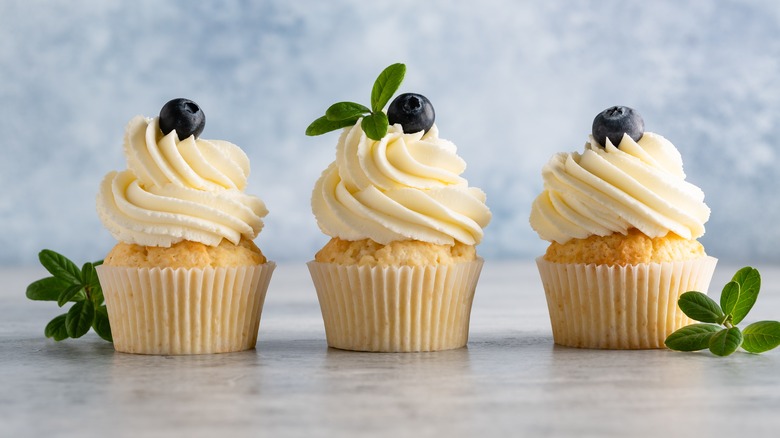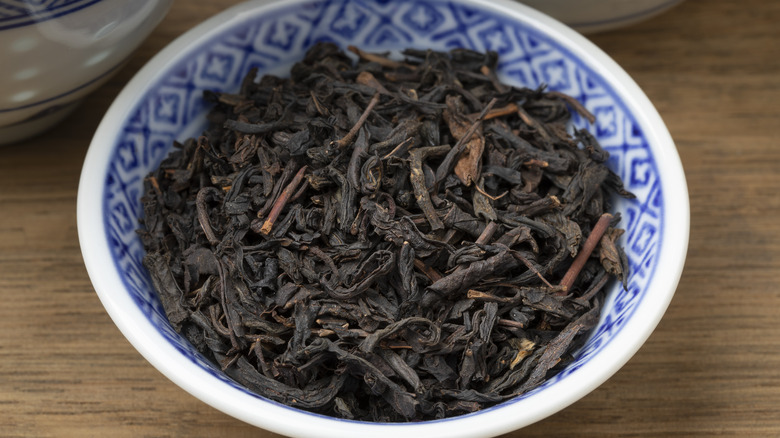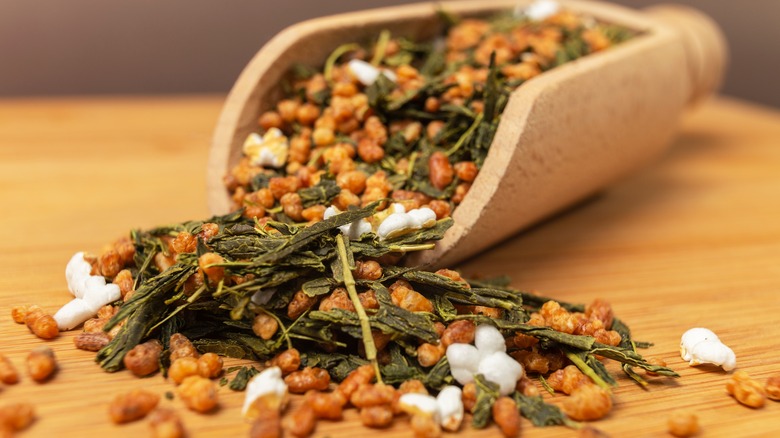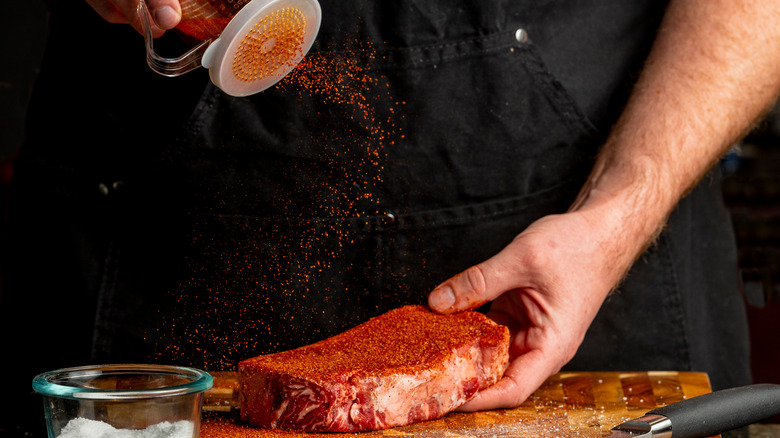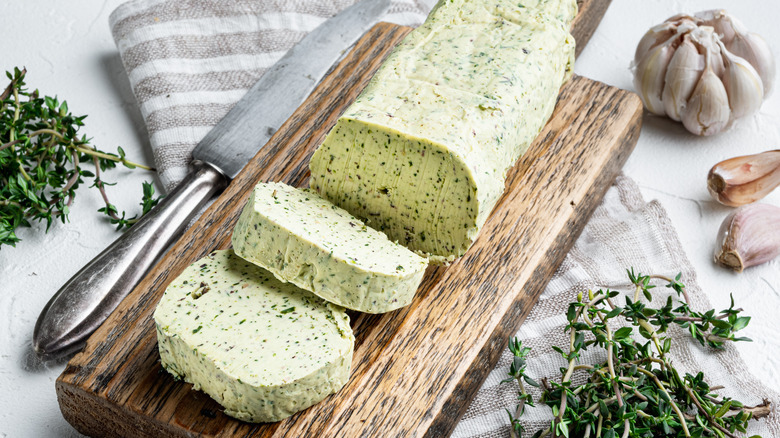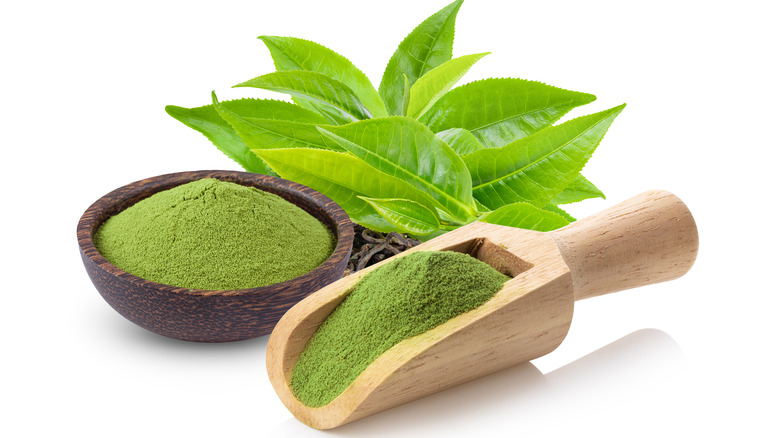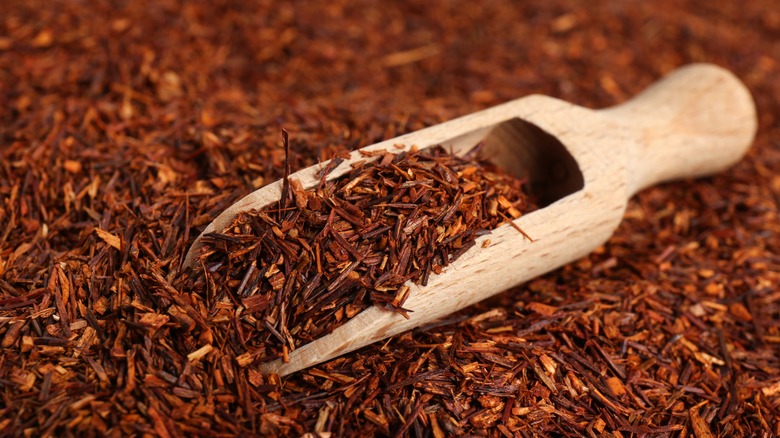12 Tips You Need When Cooking With Tea
After years of being mostly relegated to the teapot, tea is having a culinary moment right now. If you're into food, and we're assuming you are, Tasting Table reader, you probably can't open a news feed without seeing matcha-this, or Earl Grey-that. Tea is especially popular right now as a baking ingredient, with many people using floral teas to create aromatic cakes. To be fair, this isn't a brand-new TikTok technique. For example, Tea Brack is a traditional Irish bread made with dried fruit that's been soaked in breakfast tea.
Perhaps what is slightly newer is the use of tea as a savory ingredient. For example, using loose-leaf tea to elevate smoky meat rubs and marinades is becoming popular. Traditional rubs feature robust savory flavors like black pepper and paprika. Black tea, the Chinese tea Lapsang Souchong, and other bold teas fit in neatly with the flavors of popular rubs, elevating them into something new. It doesn't hurt that incorporating tea into a dish is pretty easy to do. If you have tea bags sitting in your cupboard, all you need to do is cut one open and add the ground tea leaves to your taste. Naturally, there are a few things you should keep in mind when cooking with tea.
Use a tea bag to retain moisture while cooking legumes
Cooking with dried legumes is a lengthy and tricky affair. You have to soak them overnight. Then, you have to simmer them in water or stock. After that, you can put them into your dish. If you have ever done this, you know that it can be tricky to properly rehydrate and cook legumes.
You can make things a lot easier on yourself by taking a tip from the recipe of Punjabi chole. This chickpea curry has a dark brown color and fragrant smell that comes from a unique spice blend and a dried Indian gooseberry called amla. Because these gooseberries can be difficult to find, many people use a bag of black tea instead. Even though this substitution changes the flavor profile and the more delicate flavors of black tea might be overpowered by the spice mix, many home cooks prefer to use a tea bag when making this curry because it helps to retain moisture while the chickpeas are being cooked.
This culinary hack can be applied to all kinds of dishes, not just Punjabi chole. So go ahead and plop a tea bag in the pot the next time you're cooking with dried legumes. Just be sure to take the tea bag out before finishing the dish.
Steep for a few minutes to flavor boost stock
Adding tea to a culinary stack is a great way to add new flavor dimensions. If you are using a tea bag to give your soup or sauce more flavor, you need to be judicious about your steep time. The amount of time you steep should depend on the type of tea you are using.
If you are using herbal tea, a good rule of thumb is to steep the tea bag for five minutes. However, you should taste as you go until the desired herbal flavor is achieved. If you are using black or green tea, you should be wary about overstepping because too much of these tea flavors can lead to bitter astringency. A good rule of thumb for green tea is to steep it for one or two minutes, while black tea should only steep for about three to five minutes. It's also a good idea to check the expiration date of your tea before using it. Some of us have a tendency to keep tea bags in the cupboard for months or even years. Adding stale tea to your stock won't give much flavor boost and it could produce off flavors.
Poach and steam with white tea
Even though it comes from the same plant as green tea and black tea, white tea is processed to bring out subtle and delicate flavors. Because of the delicate nature of white tea, it should be brewed gently: using a water temperature between 160 degrees Fahrenheit and 180 degrees Fahrenheit. White tea should also be steeped for only one to five minutes.
You should also abide by the delicate nature of this tea when using it to cook. White tea is best used to gently poach and steam things that can easily overcook. For instance, white tea is ideal for poaching Branzino filets or other whitefish. Adding citrus, soy sauce, and other Asian ingredients along with the white tea can give you a well-rounded and complex poaching liquid. White tea can also be used to steam dumplings or pork buns, infusing the dumpling wrapper or bun with complex flavor. White tea is also a great steaming liquid for zucchini or summer squash that is flavored with additional herbs.
Use matcha in dishes that are sweet or acidic
In case you haven't been paying attention, matcha is just about everywhere these days. This unique form of green tea has become super popular thanks to its unique flavor profile and high nutrient content. When cooking with matcha, it's best to think of it as a spice, not as tea. Matcha has a robust, herbal quality and subtle bitterness. It's a flavor profile that is best used in applications that are sweet or tart.
For example, dusting churros with matcha is a great way to provide a Japanese twist on the Spanish classic. The strong herbal quality and slight bitterness of the matcha cuts against the rich buttery quality of churros, which provides a great balance of flavors. Dusting churros with green powdery matcha also makes for a great, and unique, presentation.
Matcha also goes great in vinegar-based salad dressings. The herbal quality of matcha gives vinegar dressings a vibrant herbal quality and subtle earthiness. Adding lemon juice, honey, and even soy sauce to a salad dressing are great ways to play off the inclusion of matcha.
Use leaves or a tea bag for the desired effect
There are two ways to add tea to a dish when cooking: steeping a tea bag or adding these directly. If you aren't sure which approach you should use, start by thinking about how you want to impart the flavor of your tea.
If you want your tea to permeate the entire dish, you should consider steeping a tea bag in any liquid that would be next throughout the dish. For example, if you are baking tea-infused muffins, you should steep a tea bag in the milk you are using for the recipe. With this approach, be sure to steep your tea bag long enough so that the resulting liquid has enough tea flavor in it. You might want to make your liquid stronger tasting than if you were simply brewing a cup of tea.
There also may be times when you want to incorporate individual flavor accents of tea throughout your dish. For these types of applications, it's best to use individual tea leaves or ground tea. For example, adding tea leaves to a muffin recipe can create varying bursts of flavor. When going this route, you'll want to ensure your tea leaves are properly broken down. Sometimes, individual bits of loose-leaf tea can be tough and woody. You'll want to remove these bits before incorporating leaves into your dish.
Use loose-leaf tea to infuse dairy
If your recipe calls for water, stock, low-fat milk, or another type of non-viscous liquid, you can steep one or more tea bags directly in your liquid of choice. However, if you're using whole milk, half-and-half, or cream, you may want to use tea leaves rather than a tea bag.
Infusing rich dairy products with tea is a great way to lighten them and add complexity. All you need to do is add loose-leaf tea, then slowly heat your dairy product to just below the boiling point. Then, let it cool and strain out the tea leaves. This technique works great with any type of tea, but it works especially well with certain teas. When making a béchamel sauce, infusing your milk with earthy sencha green tea adds savory complexity. When making crème brûlée, whipped cream, or ice cream, adding an herbal tea to your cream can impart anything from lavender to lemon balm to chicory. Of course, there is nothing wrong with making a straight-up black tea whipped cream for your next dessert.
Make stock with Lapsang Souchong smoked tea
Although it is convenient to reach for store-bought culinary stock, these stocks pale in comparison to a homemade version. In fact, iconic food writer Mark Bittman has argued in The New York Times that using water is a better option than packaged stock, which he says tastes like salt and chemicals.
Bittman admits that making stock is a time-consuming process and you don't always have a batch of stock sitting there when you need it. However, he says that your pantry should be full of ingredients that can be easily converted into a useful culinary stock. The Chinese smoked tea Lapsang Souchong is one particular pantry item that can be used to quickly and easily make a very flavorful stock.
In as little as five minutes, and no more than 15 minutes, you simmer a pot of Lapsang Souchong and ginger, then season it to taste to make a versatile culinary stock. You can use this technique to make a quick batch of stock on-demand, or you could freeze your tea and ginger stock and it will keep for several weeks. This smoky Chinese tea is also a great addition to any poultry brine. Brining a turkey, chicken, or another type of poultry with Lapsang Souchong can impart a distinct smokiness to a bird that's destined for the oven.
Toast your own rice for genmaicha
Genmaicha is a type of Japanese tea that's made from toasted rice and high-quality tea leaves. It is often called popcorn tea because the roasting process produces bits of raise that pop open like popcorn. You can also hear a soft crackling noise when you pour hot water over this tea blend. The combination of nutty, toasted rice and tea is perfect for stir-fries, and genmaicha has also been used in brines and marinades. The toasted caramelized rice kernels perfectly balanced any astringency or bitterness from the tea leaves. The result is a mild-tasting green tea with luxurious nutty aromas.
Many Asian grocery stores and specialty tea shops will carry genmaicha, which can be found as either loose-leaf tea or in tea bags. It's also easy to make your own genmaicha blend at home. All you need to do is buy some sencha or bancha green tea and toast your own rice kernels. Start by soaking short-grain white rice in warm water for 30 minutes, and then cook it as you normally would. Then, spread your rice grains on a lined baking sheet and allow them to cool. Next, heat a large cast iron pan over medium heat and add the rice in batches, allowing enough room for individual rice grains to properly toast. After all your rice has been toasted, combine it with an equal amount of green tea leaves and use immediately or store it in an airtight container.
Use different teas to tweak your barbecue rub
Pro tip: You can turn any seasoning blend into a BBQ rub by simply adding brown sugar. Brown sugar contains molasses, which adds moisture to a seasoning blend. The sugar also caramelizes as it cooks to facilitate browning. A great example of this tip is our three-ingredient dry rub recipe, which combines garlic salt, hot smoked paprika, and brown sugar. Made from ingredients that are probably sitting in your pantry right now, this salty, tangy, sweet, and smokey rub can elevate any meat or vegetable after it hits the grill.
This same principle of adding brown sugar can also be applied to create rubs based on loose-leaf tea. The type of tea you choose for your rub should be based on the meat or vegetable you're grilling. Green tea and other mild teas are best for foods with subtle flavors, like seafood and vegetables. Black tea, Lapsang Souchong, and other bold-flavored teas are better for rich foods like steak or ribs. As with any rub, be sure to apply your tea-based rub as a thick layer and allow it to marinate for at least a couple of hours.
Make a compound tea butter that's sweet or savory
While butter is perfectly fine on its own, it takes only a few minutes to elevate it by adding ground tea leaves. Compound butter made with tea can go one of two routes: savory or sweet. On its own, the combination of tea and butter lean toward savory. But the addition of ingredients like chipotle chiles and roasted garlic can take the umami to all new levels. If you're looking to go the sweet route, a bit of brown sugar and cinnamon along with tea leaves will give you a complex and sweet treat.
If you're feeling a bit extra and have some heavy cream lying around, you can always make homemade butter. All it takes is heavy whipping cream, ice water, and a mixer that is capable of whipping at high speed. Simply whip the cream in a bowl until you start to produce clumps of salad fat that have separated from the liquid. Then, add a bit of ice water and next for another 30 seconds. Remove the clumps of butterfat, squeeze out any excess water, and mold them together into a single clump of butter. You can now start adding flavorings to make your compound butter.
Don't buy fake matcha
You might be surprised to learn that a lot of matcha on the market today is fake. The term "matcha" is mostly unregulated, even though it's a premium grocery product. This situation opens the door for companies and people to make low-quality matcha and sell it at a premium price. The quality of this bootleg matcha can be pretty poor, with a taste that's off-putting.
Therefore, it's important to know how to buy real matcha. Start by checking the label for red-flag terms like "powdered green tea" or "Chinese matcha." If you're buying it in person, check out the color, the texture, and, if possible, the taste. Premium matcha should have an electric green color. The powder should be smooth and fine-grained. Ultimately, the quality of matcha comes down to its taste. Many boutique shops will allow you to sample matcha before buying it, while larger stores typically have brands that you can try at a café. At the end of the day, you should be pretty confident that what you're buying is the real deal.
Sweeteners will bring out the flavor of rooibos tea
Rooibos is a unique type of tea that originated in South Africa, and recently, it's become a popular addition to the range of tea options at your typical American café. Featuring sweet, woody, floral, herbal, and caramel flavors, rooibos tea is well-suited to culinary applications, and it has been used to make everything from ice cream to sauces to marinades. One tip courtesy of Oregon Live is to add it to caramelized onions to infuse a complex earthiness.
If you've been experimenting with rooibos tea and you're hoping to bring out more of the tea's unique flavor in a dish, try adding a bit of sugar or honey, as additional sweetness helps to bring out the floral qualities of rooibos. A great example of this is making tea cookies with rooibos sugar. The turbinado sugar used to top the cookies is simply mixed together with ground tea leaves. It's a pretty basic step that truly elevates this humble cookie recipe.
